Transformational and Servant Leadership for Minority Youth in Pakistan
VerifiedAdded on 2020/05/01
|10
|2172
|93
Essay
AI Summary
This essay explores transformational and servant leadership, specifically focusing on their application to empower minority youth, particularly the Christian community, in Pakistan. It begins by introducing the context of social exclusion faced by this community and the importance of leadership in driving social change. The essay delves into various leadership theories, including trait theory, transactional theory, transformational theory, environmental theory, and the great man theory. It then focuses on transformational leadership, detailing how its elements such as idealized influence, inspirational motivation, intellectual stimulation, and individualized considerations can be utilized to empower minority youth. Furthermore, the essay examines servant leadership, emphasizing qualities like listening, empathy, healing, awareness, and persuasion. The conclusion highlights the role of ethical leadership in societal development and the importance of fostering a positive environment to build strong relationships between leaders and their followers. The essay utilizes several references to support its claims and provide a comprehensive analysis of the topic.
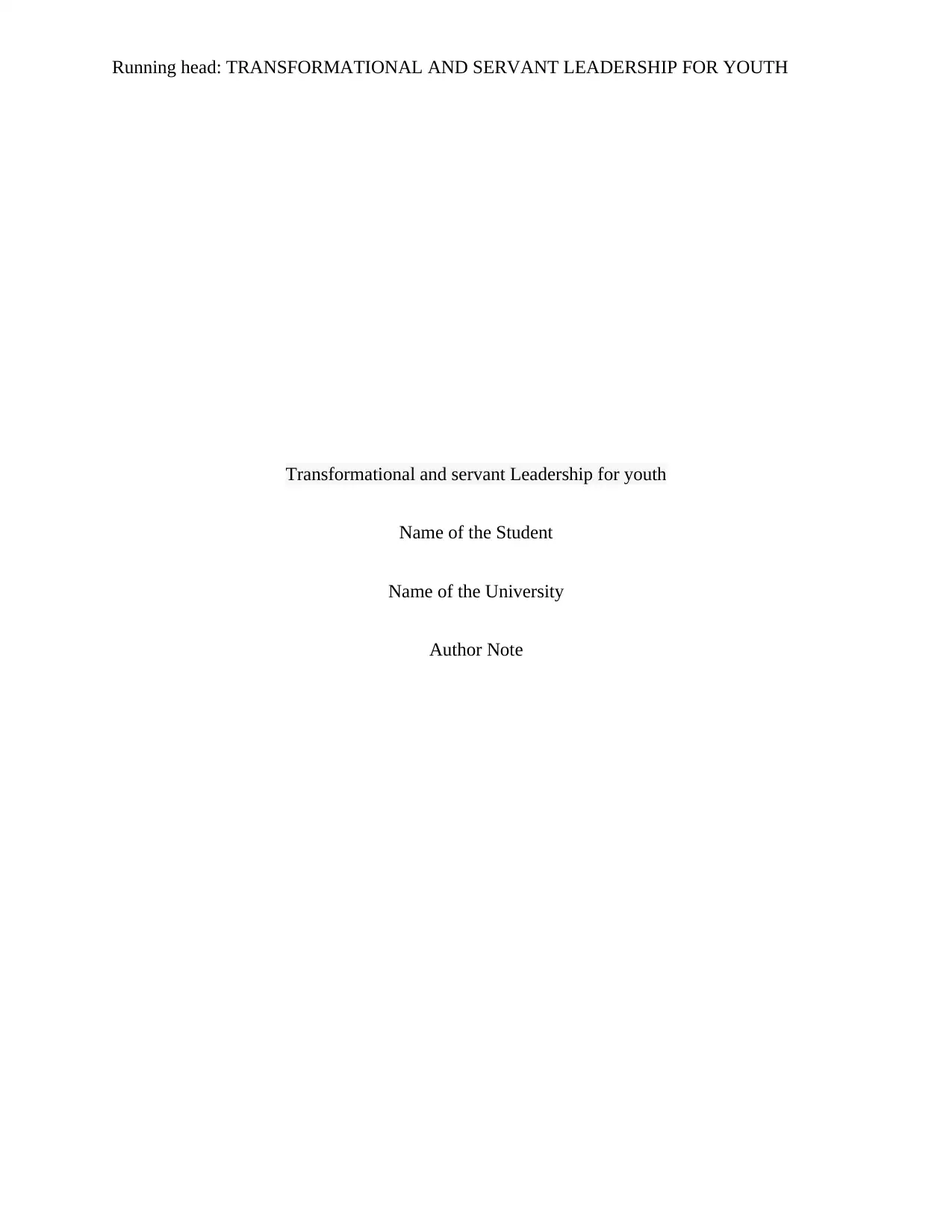
Running head: TRANSFORMATIONAL AND SERVANT LEADERSHIP FOR YOUTH
Transformational and servant Leadership for youth
Name of the Student
Name of the University
Author Note
Transformational and servant Leadership for youth
Name of the Student
Name of the University
Author Note
Paraphrase This Document
Need a fresh take? Get an instant paraphrase of this document with our AI Paraphraser
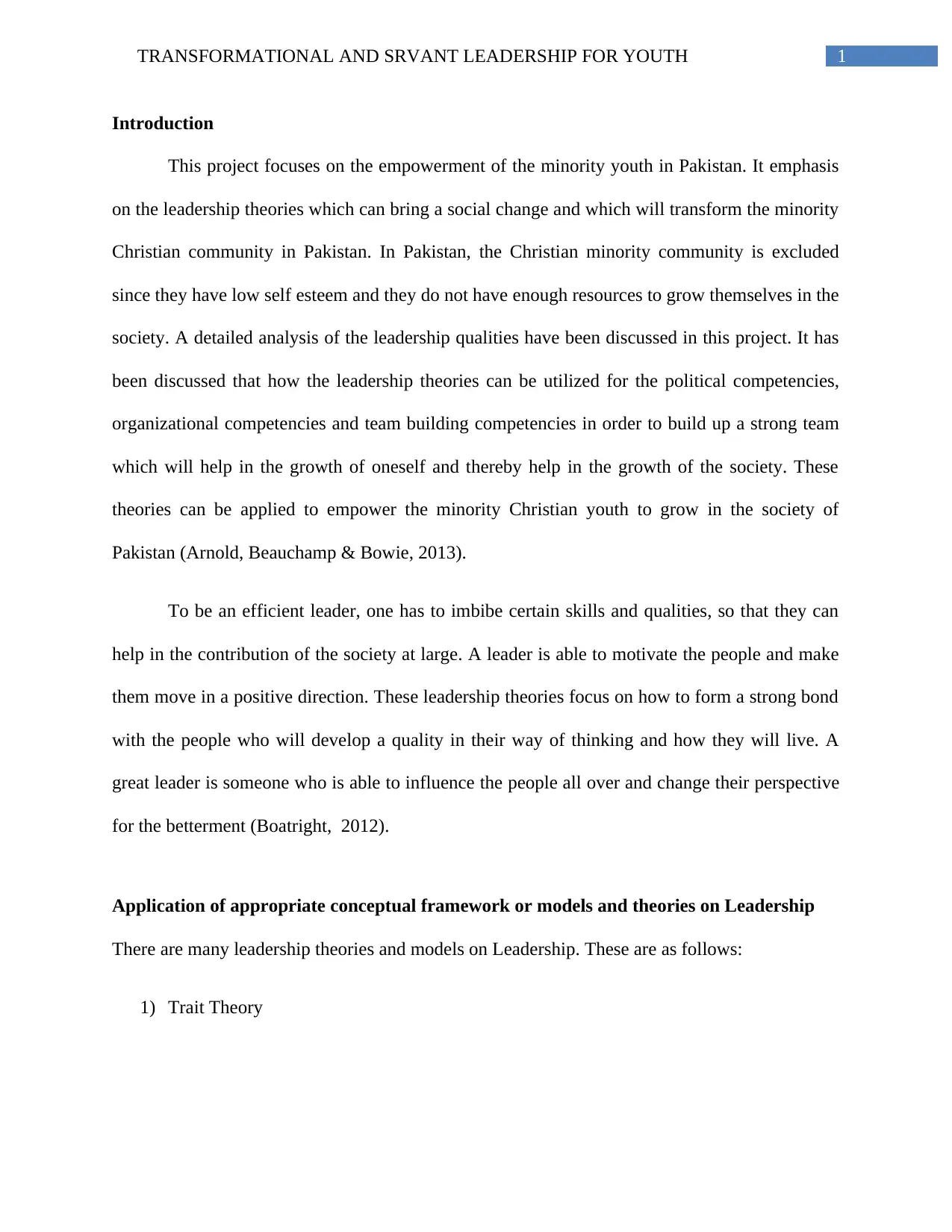
1TRANSFORMATIONAL AND SRVANT LEADERSHIP FOR YOUTH
Introduction
This project focuses on the empowerment of the minority youth in Pakistan. It emphasis
on the leadership theories which can bring a social change and which will transform the minority
Christian community in Pakistan. In Pakistan, the Christian minority community is excluded
since they have low self esteem and they do not have enough resources to grow themselves in the
society. A detailed analysis of the leadership qualities have been discussed in this project. It has
been discussed that how the leadership theories can be utilized for the political competencies,
organizational competencies and team building competencies in order to build up a strong team
which will help in the growth of oneself and thereby help in the growth of the society. These
theories can be applied to empower the minority Christian youth to grow in the society of
Pakistan (Arnold, Beauchamp & Bowie, 2013).
To be an efficient leader, one has to imbibe certain skills and qualities, so that they can
help in the contribution of the society at large. A leader is able to motivate the people and make
them move in a positive direction. These leadership theories focus on how to form a strong bond
with the people who will develop a quality in their way of thinking and how they will live. A
great leader is someone who is able to influence the people all over and change their perspective
for the betterment (Boatright, 2012).
Application of appropriate conceptual framework or models and theories on Leadership
There are many leadership theories and models on Leadership. These are as follows:
1) Trait Theory
Introduction
This project focuses on the empowerment of the minority youth in Pakistan. It emphasis
on the leadership theories which can bring a social change and which will transform the minority
Christian community in Pakistan. In Pakistan, the Christian minority community is excluded
since they have low self esteem and they do not have enough resources to grow themselves in the
society. A detailed analysis of the leadership qualities have been discussed in this project. It has
been discussed that how the leadership theories can be utilized for the political competencies,
organizational competencies and team building competencies in order to build up a strong team
which will help in the growth of oneself and thereby help in the growth of the society. These
theories can be applied to empower the minority Christian youth to grow in the society of
Pakistan (Arnold, Beauchamp & Bowie, 2013).
To be an efficient leader, one has to imbibe certain skills and qualities, so that they can
help in the contribution of the society at large. A leader is able to motivate the people and make
them move in a positive direction. These leadership theories focus on how to form a strong bond
with the people who will develop a quality in their way of thinking and how they will live. A
great leader is someone who is able to influence the people all over and change their perspective
for the betterment (Boatright, 2012).
Application of appropriate conceptual framework or models and theories on Leadership
There are many leadership theories and models on Leadership. These are as follows:
1) Trait Theory
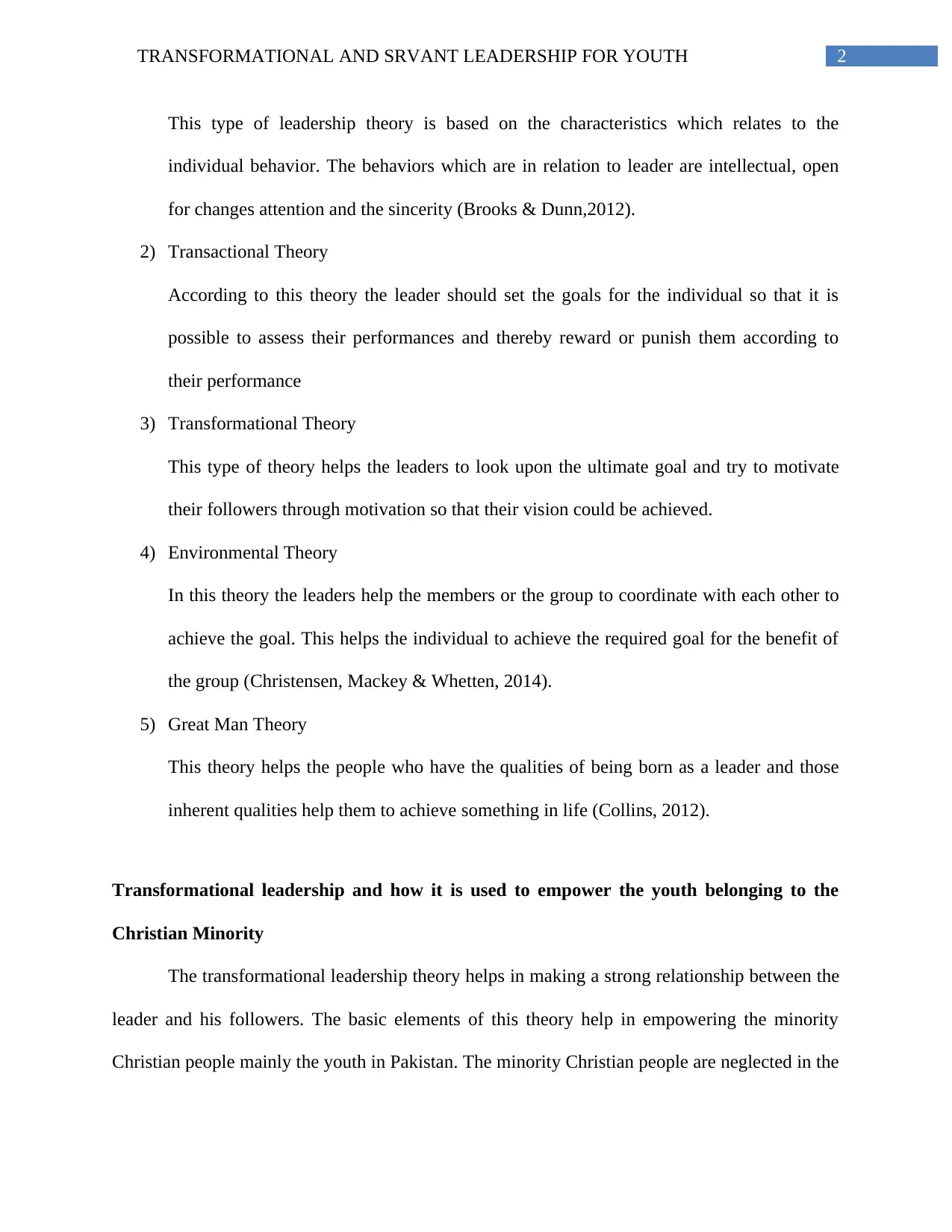
2TRANSFORMATIONAL AND SRVANT LEADERSHIP FOR YOUTH
This type of leadership theory is based on the characteristics which relates to the
individual behavior. The behaviors which are in relation to leader are intellectual, open
for changes attention and the sincerity (Brooks & Dunn,2012).
2) Transactional Theory
According to this theory the leader should set the goals for the individual so that it is
possible to assess their performances and thereby reward or punish them according to
their performance
3) Transformational Theory
This type of theory helps the leaders to look upon the ultimate goal and try to motivate
their followers through motivation so that their vision could be achieved.
4) Environmental Theory
In this theory the leaders help the members or the group to coordinate with each other to
achieve the goal. This helps the individual to achieve the required goal for the benefit of
the group (Christensen, Mackey & Whetten, 2014).
5) Great Man Theory
This theory helps the people who have the qualities of being born as a leader and those
inherent qualities help them to achieve something in life (Collins, 2012).
Transformational leadership and how it is used to empower the youth belonging to the
Christian Minority
The transformational leadership theory helps in making a strong relationship between the
leader and his followers. The basic elements of this theory help in empowering the minority
Christian people mainly the youth in Pakistan. The minority Christian people are neglected in the
This type of leadership theory is based on the characteristics which relates to the
individual behavior. The behaviors which are in relation to leader are intellectual, open
for changes attention and the sincerity (Brooks & Dunn,2012).
2) Transactional Theory
According to this theory the leader should set the goals for the individual so that it is
possible to assess their performances and thereby reward or punish them according to
their performance
3) Transformational Theory
This type of theory helps the leaders to look upon the ultimate goal and try to motivate
their followers through motivation so that their vision could be achieved.
4) Environmental Theory
In this theory the leaders help the members or the group to coordinate with each other to
achieve the goal. This helps the individual to achieve the required goal for the benefit of
the group (Christensen, Mackey & Whetten, 2014).
5) Great Man Theory
This theory helps the people who have the qualities of being born as a leader and those
inherent qualities help them to achieve something in life (Collins, 2012).
Transformational leadership and how it is used to empower the youth belonging to the
Christian Minority
The transformational leadership theory helps in making a strong relationship between the
leader and his followers. The basic elements of this theory help in empowering the minority
Christian people mainly the youth in Pakistan. The minority Christian people are neglected in the
⊘ This is a preview!⊘
Do you want full access?
Subscribe today to unlock all pages.

Trusted by 1+ million students worldwide
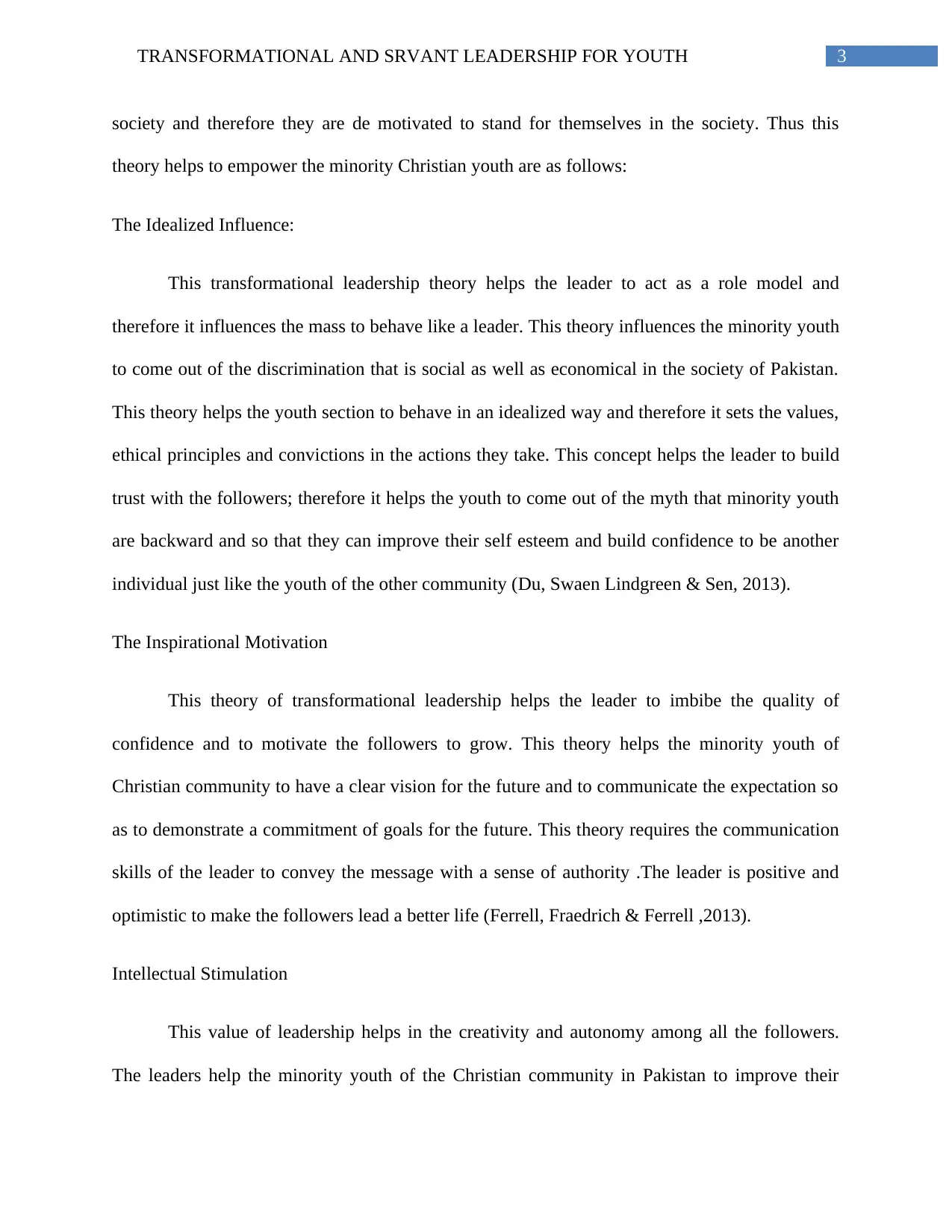
3TRANSFORMATIONAL AND SRVANT LEADERSHIP FOR YOUTH
society and therefore they are de motivated to stand for themselves in the society. Thus this
theory helps to empower the minority Christian youth are as follows:
The Idealized Influence:
This transformational leadership theory helps the leader to act as a role model and
therefore it influences the mass to behave like a leader. This theory influences the minority youth
to come out of the discrimination that is social as well as economical in the society of Pakistan.
This theory helps the youth section to behave in an idealized way and therefore it sets the values,
ethical principles and convictions in the actions they take. This concept helps the leader to build
trust with the followers; therefore it helps the youth to come out of the myth that minority youth
are backward and so that they can improve their self esteem and build confidence to be another
individual just like the youth of the other community (Du, Swaen Lindgreen & Sen, 2013).
The Inspirational Motivation
This theory of transformational leadership helps the leader to imbibe the quality of
confidence and to motivate the followers to grow. This theory helps the minority youth of
Christian community to have a clear vision for the future and to communicate the expectation so
as to demonstrate a commitment of goals for the future. This theory requires the communication
skills of the leader to convey the message with a sense of authority .The leader is positive and
optimistic to make the followers lead a better life (Ferrell, Fraedrich & Ferrell ,2013).
Intellectual Stimulation
This value of leadership helps in the creativity and autonomy among all the followers.
The leaders help the minority youth of the Christian community in Pakistan to improve their
society and therefore they are de motivated to stand for themselves in the society. Thus this
theory helps to empower the minority Christian youth are as follows:
The Idealized Influence:
This transformational leadership theory helps the leader to act as a role model and
therefore it influences the mass to behave like a leader. This theory influences the minority youth
to come out of the discrimination that is social as well as economical in the society of Pakistan.
This theory helps the youth section to behave in an idealized way and therefore it sets the values,
ethical principles and convictions in the actions they take. This concept helps the leader to build
trust with the followers; therefore it helps the youth to come out of the myth that minority youth
are backward and so that they can improve their self esteem and build confidence to be another
individual just like the youth of the other community (Du, Swaen Lindgreen & Sen, 2013).
The Inspirational Motivation
This theory of transformational leadership helps the leader to imbibe the quality of
confidence and to motivate the followers to grow. This theory helps the minority youth of
Christian community to have a clear vision for the future and to communicate the expectation so
as to demonstrate a commitment of goals for the future. This theory requires the communication
skills of the leader to convey the message with a sense of authority .The leader is positive and
optimistic to make the followers lead a better life (Ferrell, Fraedrich & Ferrell ,2013).
Intellectual Stimulation
This value of leadership helps in the creativity and autonomy among all the followers.
The leaders help the minority youth of the Christian community in Pakistan to improve their
Paraphrase This Document
Need a fresh take? Get an instant paraphrase of this document with our AI Paraphraser
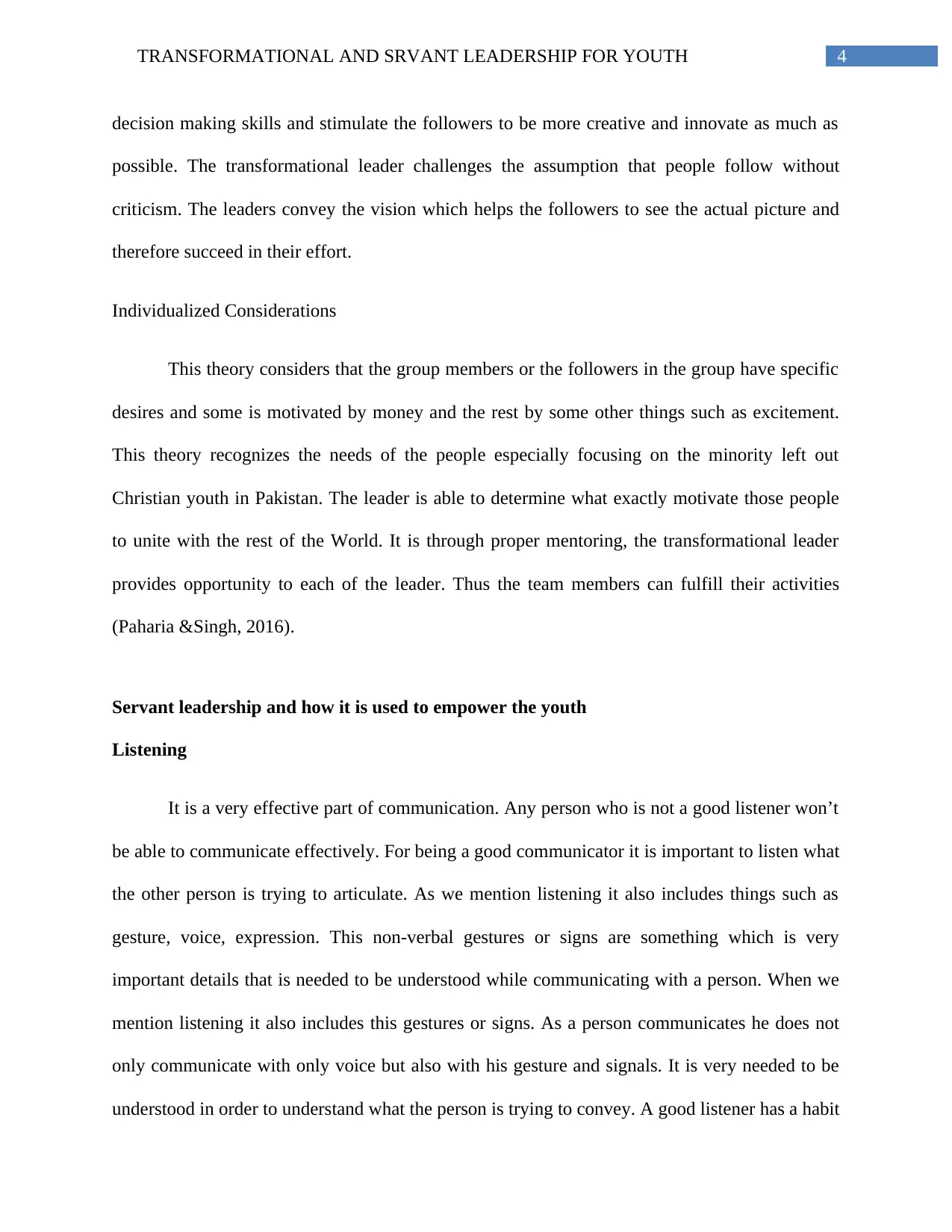
4TRANSFORMATIONAL AND SRVANT LEADERSHIP FOR YOUTH
decision making skills and stimulate the followers to be more creative and innovate as much as
possible. The transformational leader challenges the assumption that people follow without
criticism. The leaders convey the vision which helps the followers to see the actual picture and
therefore succeed in their effort.
Individualized Considerations
This theory considers that the group members or the followers in the group have specific
desires and some is motivated by money and the rest by some other things such as excitement.
This theory recognizes the needs of the people especially focusing on the minority left out
Christian youth in Pakistan. The leader is able to determine what exactly motivate those people
to unite with the rest of the World. It is through proper mentoring, the transformational leader
provides opportunity to each of the leader. Thus the team members can fulfill their activities
(Paharia &Singh, 2016).
Servant leadership and how it is used to empower the youth
Listening
It is a very effective part of communication. Any person who is not a good listener won’t
be able to communicate effectively. For being a good communicator it is important to listen what
the other person is trying to articulate. As we mention listening it also includes things such as
gesture, voice, expression. This non-verbal gestures or signs are something which is very
important details that is needed to be understood while communicating with a person. When we
mention listening it also includes this gestures or signs. As a person communicates he does not
only communicate with only voice but also with his gesture and signals. It is very needed to be
understood in order to understand what the person is trying to convey. A good listener has a habit
decision making skills and stimulate the followers to be more creative and innovate as much as
possible. The transformational leader challenges the assumption that people follow without
criticism. The leaders convey the vision which helps the followers to see the actual picture and
therefore succeed in their effort.
Individualized Considerations
This theory considers that the group members or the followers in the group have specific
desires and some is motivated by money and the rest by some other things such as excitement.
This theory recognizes the needs of the people especially focusing on the minority left out
Christian youth in Pakistan. The leader is able to determine what exactly motivate those people
to unite with the rest of the World. It is through proper mentoring, the transformational leader
provides opportunity to each of the leader. Thus the team members can fulfill their activities
(Paharia &Singh, 2016).
Servant leadership and how it is used to empower the youth
Listening
It is a very effective part of communication. Any person who is not a good listener won’t
be able to communicate effectively. For being a good communicator it is important to listen what
the other person is trying to articulate. As we mention listening it also includes things such as
gesture, voice, expression. This non-verbal gestures or signs are something which is very
important details that is needed to be understood while communicating with a person. When we
mention listening it also includes this gestures or signs. As a person communicates he does not
only communicate with only voice but also with his gesture and signals. It is very needed to be
understood in order to understand what the person is trying to convey. A good listener has a habit
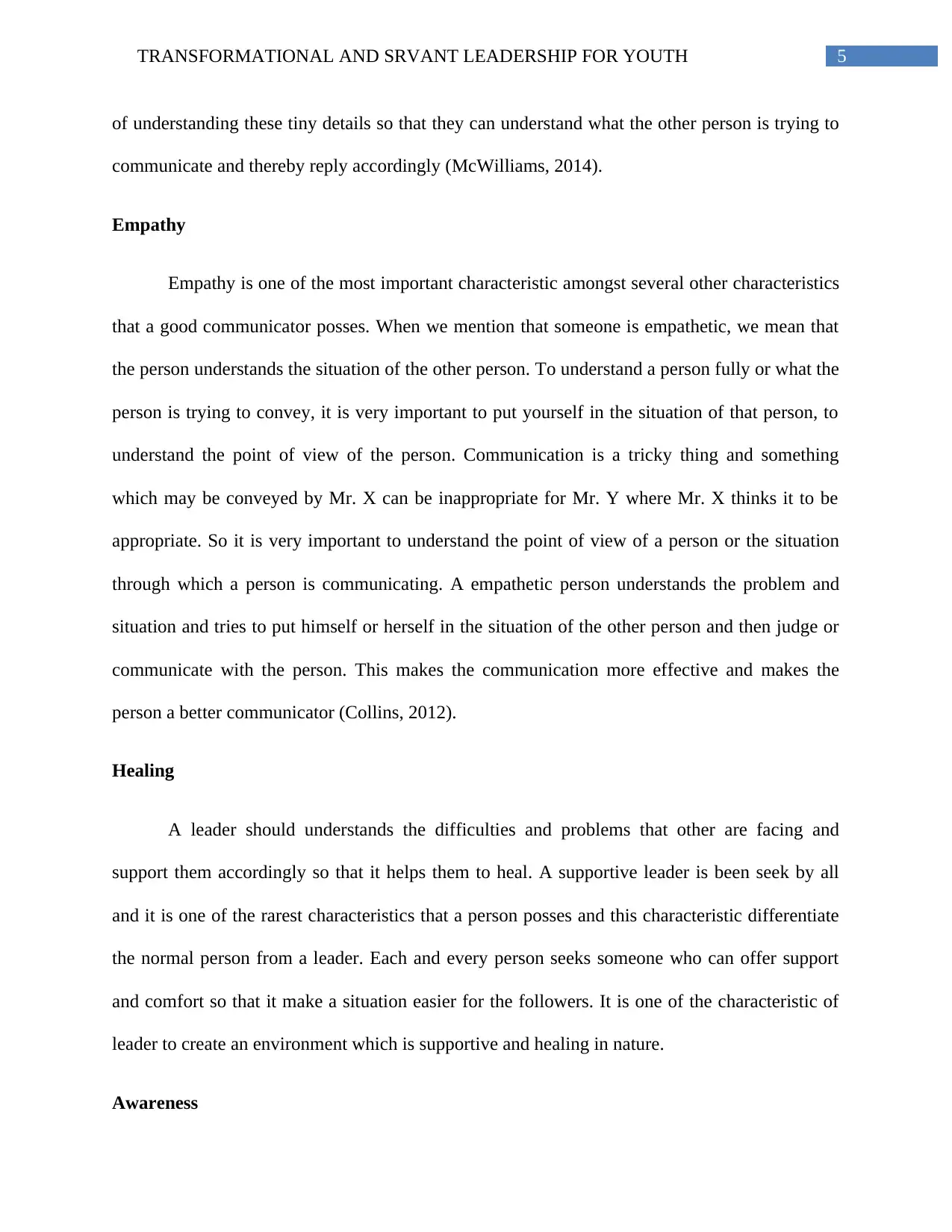
5TRANSFORMATIONAL AND SRVANT LEADERSHIP FOR YOUTH
of understanding these tiny details so that they can understand what the other person is trying to
communicate and thereby reply accordingly (McWilliams, 2014).
Empathy
Empathy is one of the most important characteristic amongst several other characteristics
that a good communicator posses. When we mention that someone is empathetic, we mean that
the person understands the situation of the other person. To understand a person fully or what the
person is trying to convey, it is very important to put yourself in the situation of that person, to
understand the point of view of the person. Communication is a tricky thing and something
which may be conveyed by Mr. X can be inappropriate for Mr. Y where Mr. X thinks it to be
appropriate. So it is very important to understand the point of view of a person or the situation
through which a person is communicating. A empathetic person understands the problem and
situation and tries to put himself or herself in the situation of the other person and then judge or
communicate with the person. This makes the communication more effective and makes the
person a better communicator (Collins, 2012).
Healing
A leader should understands the difficulties and problems that other are facing and
support them accordingly so that it helps them to heal. A supportive leader is been seek by all
and it is one of the rarest characteristics that a person posses and this characteristic differentiate
the normal person from a leader. Each and every person seeks someone who can offer support
and comfort so that it make a situation easier for the followers. It is one of the characteristic of
leader to create an environment which is supportive and healing in nature.
Awareness
of understanding these tiny details so that they can understand what the other person is trying to
communicate and thereby reply accordingly (McWilliams, 2014).
Empathy
Empathy is one of the most important characteristic amongst several other characteristics
that a good communicator posses. When we mention that someone is empathetic, we mean that
the person understands the situation of the other person. To understand a person fully or what the
person is trying to convey, it is very important to put yourself in the situation of that person, to
understand the point of view of the person. Communication is a tricky thing and something
which may be conveyed by Mr. X can be inappropriate for Mr. Y where Mr. X thinks it to be
appropriate. So it is very important to understand the point of view of a person or the situation
through which a person is communicating. A empathetic person understands the problem and
situation and tries to put himself or herself in the situation of the other person and then judge or
communicate with the person. This makes the communication more effective and makes the
person a better communicator (Collins, 2012).
Healing
A leader should understands the difficulties and problems that other are facing and
support them accordingly so that it helps them to heal. A supportive leader is been seek by all
and it is one of the rarest characteristics that a person posses and this characteristic differentiate
the normal person from a leader. Each and every person seeks someone who can offer support
and comfort so that it make a situation easier for the followers. It is one of the characteristic of
leader to create an environment which is supportive and healing in nature.
Awareness
⊘ This is a preview!⊘
Do you want full access?
Subscribe today to unlock all pages.

Trusted by 1+ million students worldwide
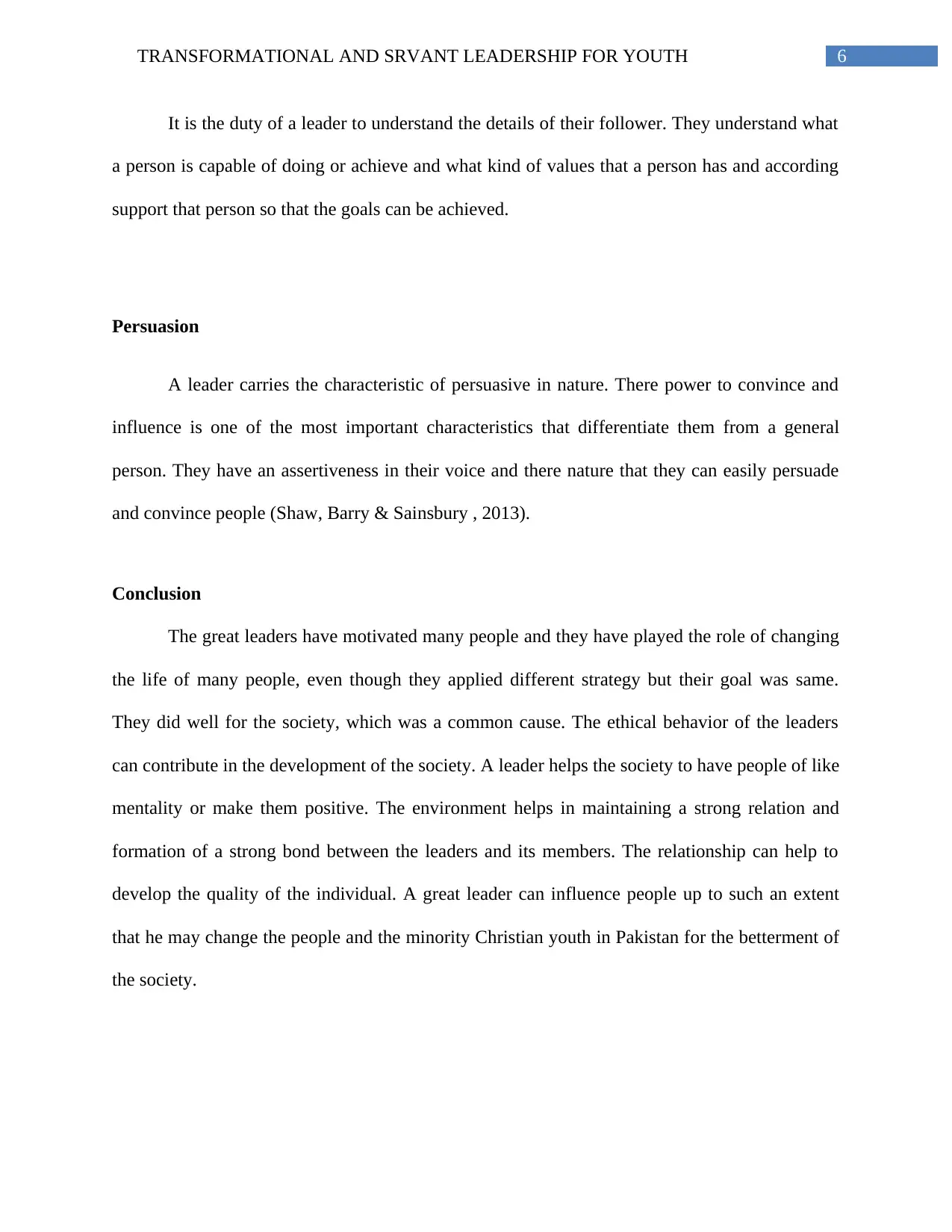
6TRANSFORMATIONAL AND SRVANT LEADERSHIP FOR YOUTH
It is the duty of a leader to understand the details of their follower. They understand what
a person is capable of doing or achieve and what kind of values that a person has and according
support that person so that the goals can be achieved.
Persuasion
A leader carries the characteristic of persuasive in nature. There power to convince and
influence is one of the most important characteristics that differentiate them from a general
person. They have an assertiveness in their voice and there nature that they can easily persuade
and convince people (Shaw, Barry & Sainsbury , 2013).
Conclusion
The great leaders have motivated many people and they have played the role of changing
the life of many people, even though they applied different strategy but their goal was same.
They did well for the society, which was a common cause. The ethical behavior of the leaders
can contribute in the development of the society. A leader helps the society to have people of like
mentality or make them positive. The environment helps in maintaining a strong relation and
formation of a strong bond between the leaders and its members. The relationship can help to
develop the quality of the individual. A great leader can influence people up to such an extent
that he may change the people and the minority Christian youth in Pakistan for the betterment of
the society.
It is the duty of a leader to understand the details of their follower. They understand what
a person is capable of doing or achieve and what kind of values that a person has and according
support that person so that the goals can be achieved.
Persuasion
A leader carries the characteristic of persuasive in nature. There power to convince and
influence is one of the most important characteristics that differentiate them from a general
person. They have an assertiveness in their voice and there nature that they can easily persuade
and convince people (Shaw, Barry & Sainsbury , 2013).
Conclusion
The great leaders have motivated many people and they have played the role of changing
the life of many people, even though they applied different strategy but their goal was same.
They did well for the society, which was a common cause. The ethical behavior of the leaders
can contribute in the development of the society. A leader helps the society to have people of like
mentality or make them positive. The environment helps in maintaining a strong relation and
formation of a strong bond between the leaders and its members. The relationship can help to
develop the quality of the individual. A great leader can influence people up to such an extent
that he may change the people and the minority Christian youth in Pakistan for the betterment of
the society.
Paraphrase This Document
Need a fresh take? Get an instant paraphrase of this document with our AI Paraphraser
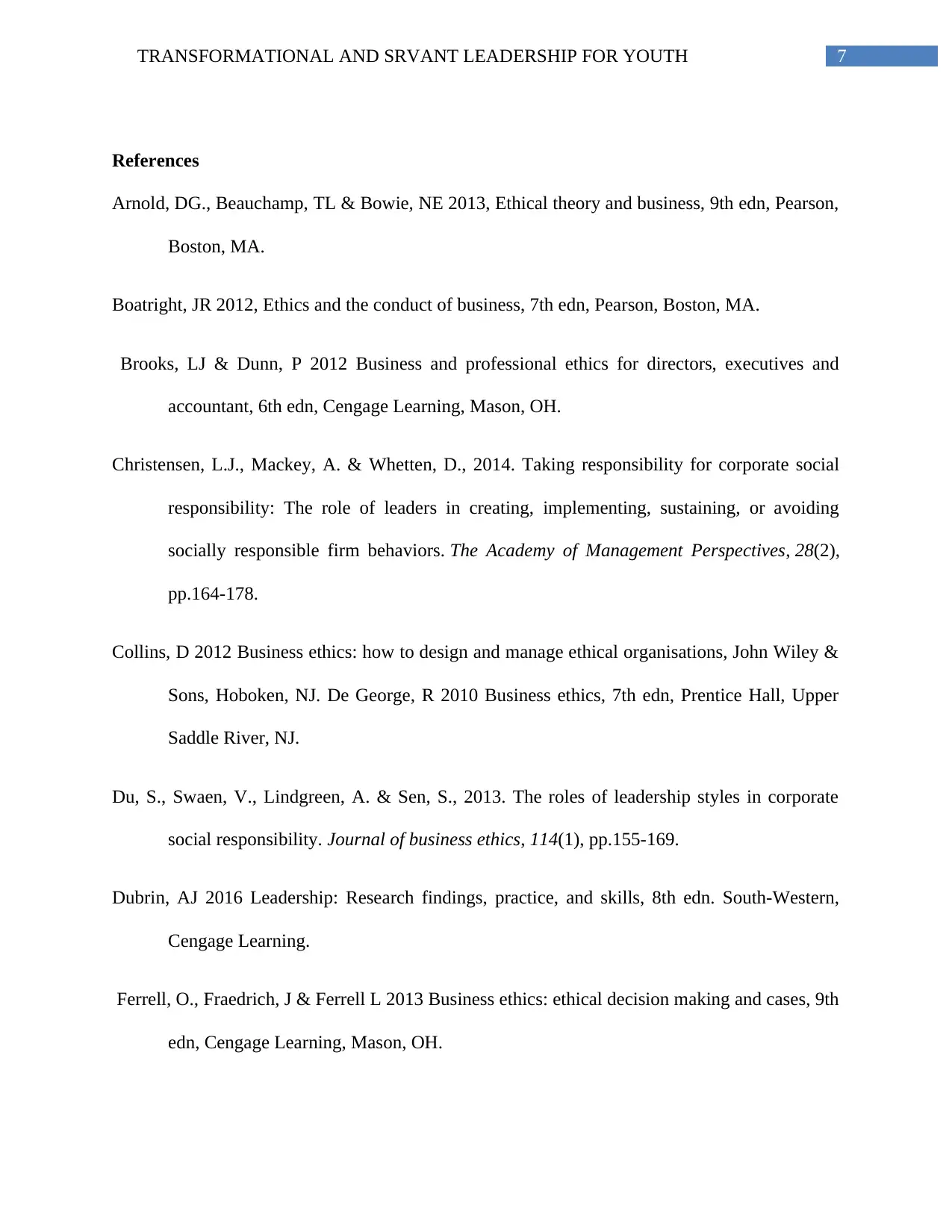
7TRANSFORMATIONAL AND SRVANT LEADERSHIP FOR YOUTH
References
Arnold, DG., Beauchamp, TL & Bowie, NE 2013, Ethical theory and business, 9th edn, Pearson,
Boston, MA.
Boatright, JR 2012, Ethics and the conduct of business, 7th edn, Pearson, Boston, MA.
Brooks, LJ & Dunn, P 2012 Business and professional ethics for directors, executives and
accountant, 6th edn, Cengage Learning, Mason, OH.
Christensen, L.J., Mackey, A. & Whetten, D., 2014. Taking responsibility for corporate social
responsibility: The role of leaders in creating, implementing, sustaining, or avoiding
socially responsible firm behaviors. The Academy of Management Perspectives, 28(2),
pp.164-178.
Collins, D 2012 Business ethics: how to design and manage ethical organisations, John Wiley &
Sons, Hoboken, NJ. De George, R 2010 Business ethics, 7th edn, Prentice Hall, Upper
Saddle River, NJ.
Du, S., Swaen, V., Lindgreen, A. & Sen, S., 2013. The roles of leadership styles in corporate
social responsibility. Journal of business ethics, 114(1), pp.155-169.
Dubrin, AJ 2016 Leadership: Research findings, practice, and skills, 8th edn. South-Western,
Cengage Learning.
Ferrell, O., Fraedrich, J & Ferrell L 2013 Business ethics: ethical decision making and cases, 9th
edn, Cengage Learning, Mason, OH.
References
Arnold, DG., Beauchamp, TL & Bowie, NE 2013, Ethical theory and business, 9th edn, Pearson,
Boston, MA.
Boatright, JR 2012, Ethics and the conduct of business, 7th edn, Pearson, Boston, MA.
Brooks, LJ & Dunn, P 2012 Business and professional ethics for directors, executives and
accountant, 6th edn, Cengage Learning, Mason, OH.
Christensen, L.J., Mackey, A. & Whetten, D., 2014. Taking responsibility for corporate social
responsibility: The role of leaders in creating, implementing, sustaining, or avoiding
socially responsible firm behaviors. The Academy of Management Perspectives, 28(2),
pp.164-178.
Collins, D 2012 Business ethics: how to design and manage ethical organisations, John Wiley &
Sons, Hoboken, NJ. De George, R 2010 Business ethics, 7th edn, Prentice Hall, Upper
Saddle River, NJ.
Du, S., Swaen, V., Lindgreen, A. & Sen, S., 2013. The roles of leadership styles in corporate
social responsibility. Journal of business ethics, 114(1), pp.155-169.
Dubrin, AJ 2016 Leadership: Research findings, practice, and skills, 8th edn. South-Western,
Cengage Learning.
Ferrell, O., Fraedrich, J & Ferrell L 2013 Business ethics: ethical decision making and cases, 9th
edn, Cengage Learning, Mason, OH.
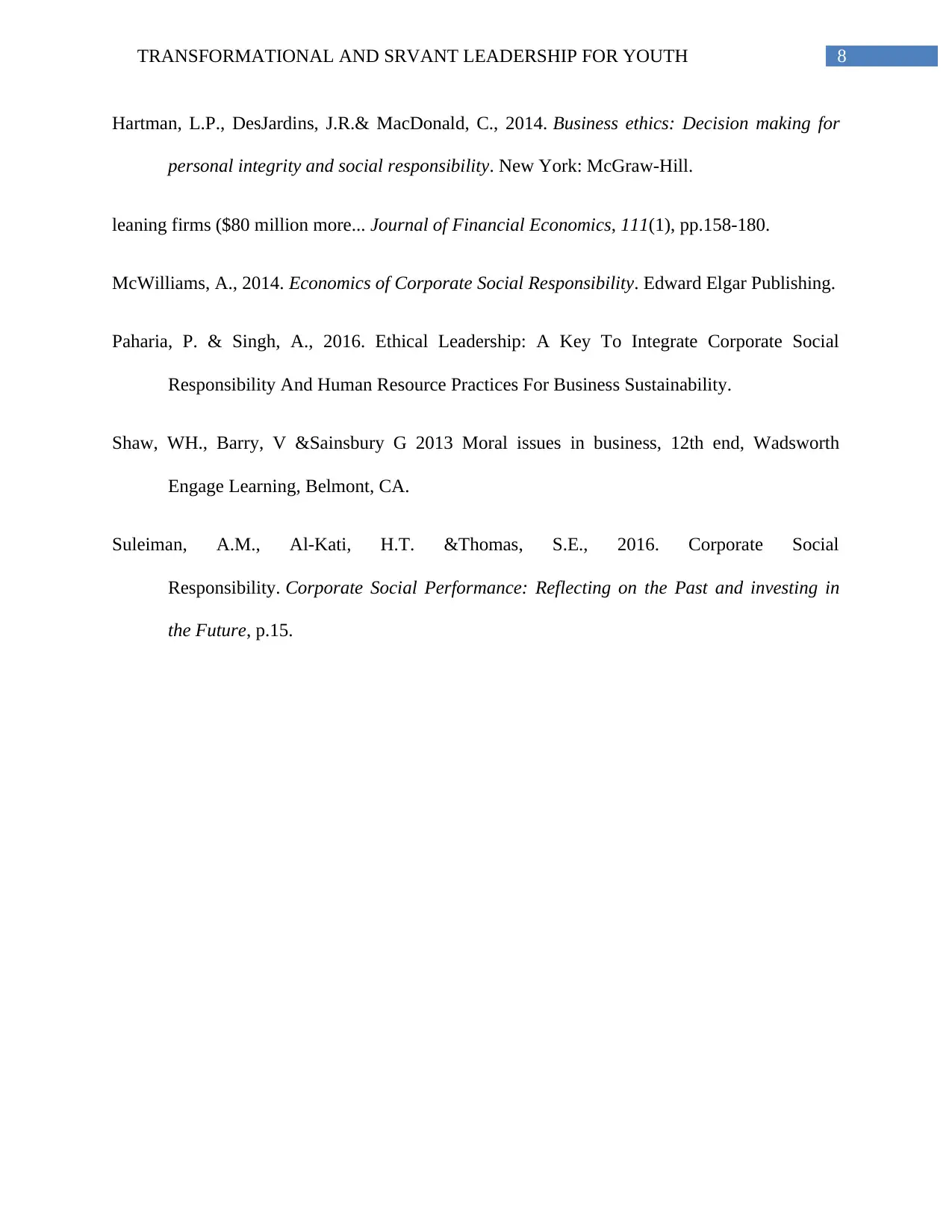
8TRANSFORMATIONAL AND SRVANT LEADERSHIP FOR YOUTH
Hartman, L.P., DesJardins, J.R.& MacDonald, C., 2014. Business ethics: Decision making for
personal integrity and social responsibility. New York: McGraw-Hill.
leaning firms ($80 million more... Journal of Financial Economics, 111(1), pp.158-180.
McWilliams, A., 2014. Economics of Corporate Social Responsibility. Edward Elgar Publishing.
Paharia, P. & Singh, A., 2016. Ethical Leadership: A Key To Integrate Corporate Social
Responsibility And Human Resource Practices For Business Sustainability.
Shaw, WH., Barry, V &Sainsbury G 2013 Moral issues in business, 12th end, Wadsworth
Engage Learning, Belmont, CA.
Suleiman, A.M., Al-Kati, H.T. &Thomas, S.E., 2016. Corporate Social
Responsibility. Corporate Social Performance: Reflecting on the Past and investing in
the Future, p.15.
Hartman, L.P., DesJardins, J.R.& MacDonald, C., 2014. Business ethics: Decision making for
personal integrity and social responsibility. New York: McGraw-Hill.
leaning firms ($80 million more... Journal of Financial Economics, 111(1), pp.158-180.
McWilliams, A., 2014. Economics of Corporate Social Responsibility. Edward Elgar Publishing.
Paharia, P. & Singh, A., 2016. Ethical Leadership: A Key To Integrate Corporate Social
Responsibility And Human Resource Practices For Business Sustainability.
Shaw, WH., Barry, V &Sainsbury G 2013 Moral issues in business, 12th end, Wadsworth
Engage Learning, Belmont, CA.
Suleiman, A.M., Al-Kati, H.T. &Thomas, S.E., 2016. Corporate Social
Responsibility. Corporate Social Performance: Reflecting on the Past and investing in
the Future, p.15.
⊘ This is a preview!⊘
Do you want full access?
Subscribe today to unlock all pages.

Trusted by 1+ million students worldwide

9TRANSFORMATIONAL AND SRVANT LEADERSHIP FOR YOUTH
1 out of 10
Related Documents
Your All-in-One AI-Powered Toolkit for Academic Success.
+13062052269
info@desklib.com
Available 24*7 on WhatsApp / Email
![[object Object]](/_next/static/media/star-bottom.7253800d.svg)
Unlock your academic potential
Copyright © 2020–2025 A2Z Services. All Rights Reserved. Developed and managed by ZUCOL.





